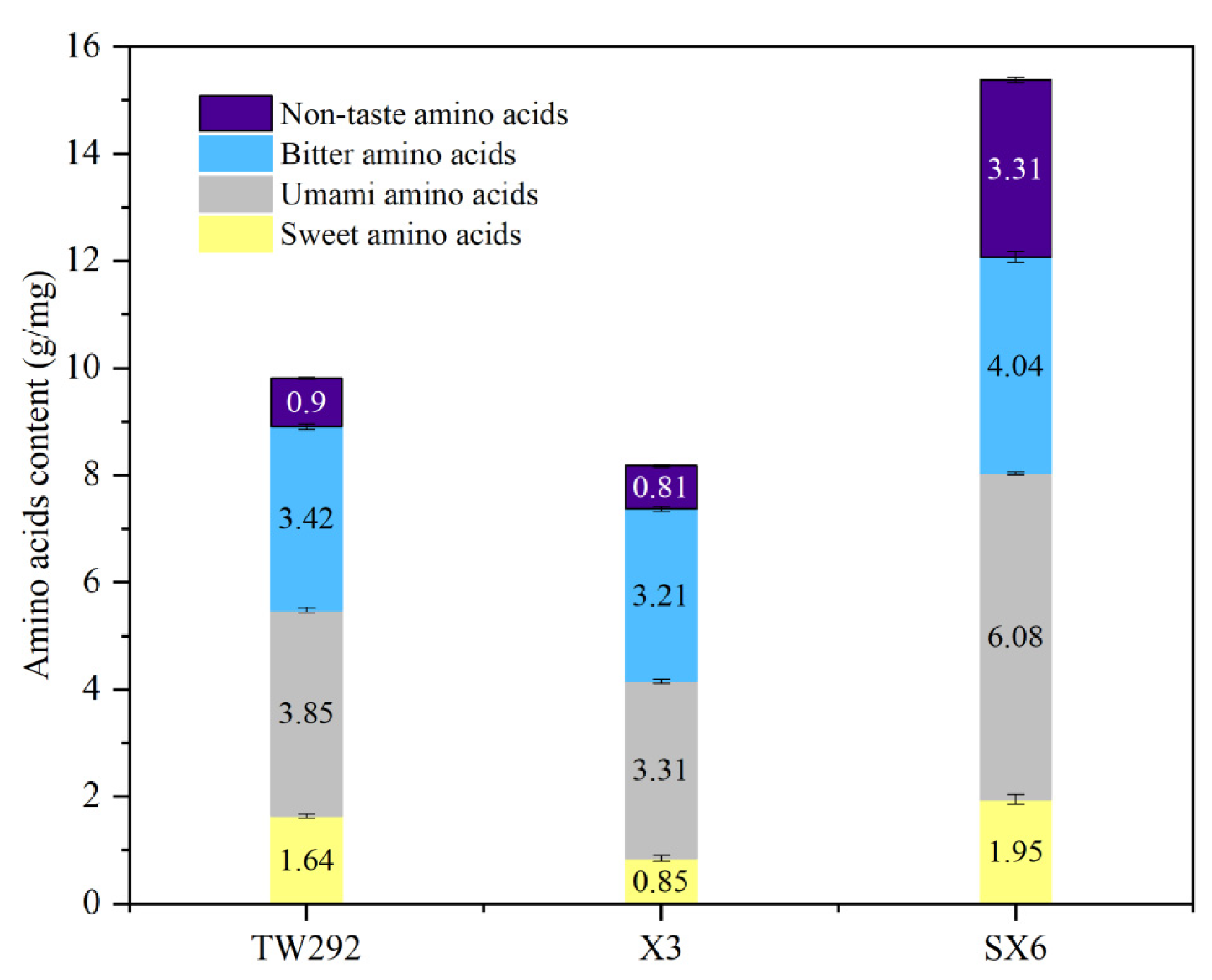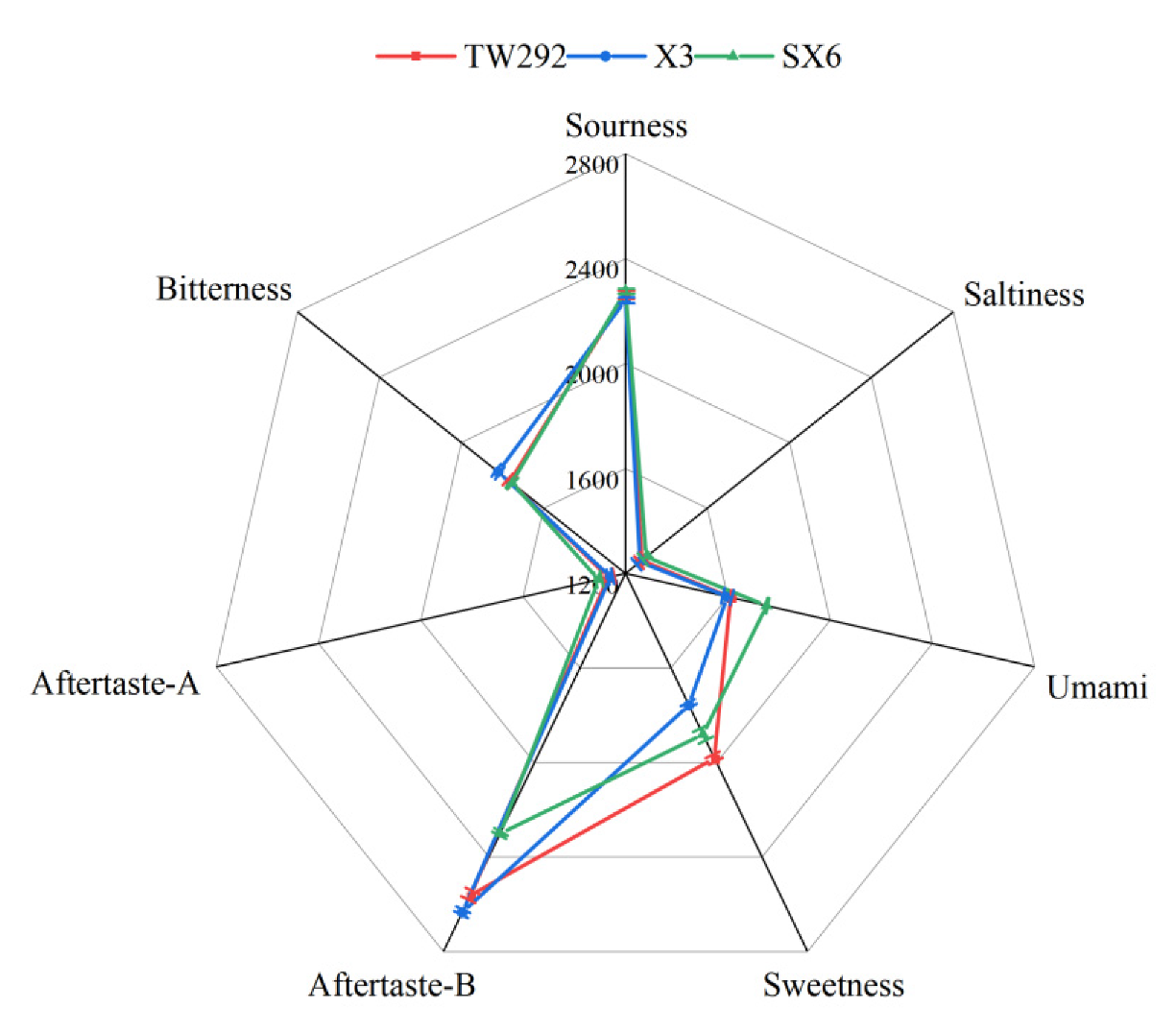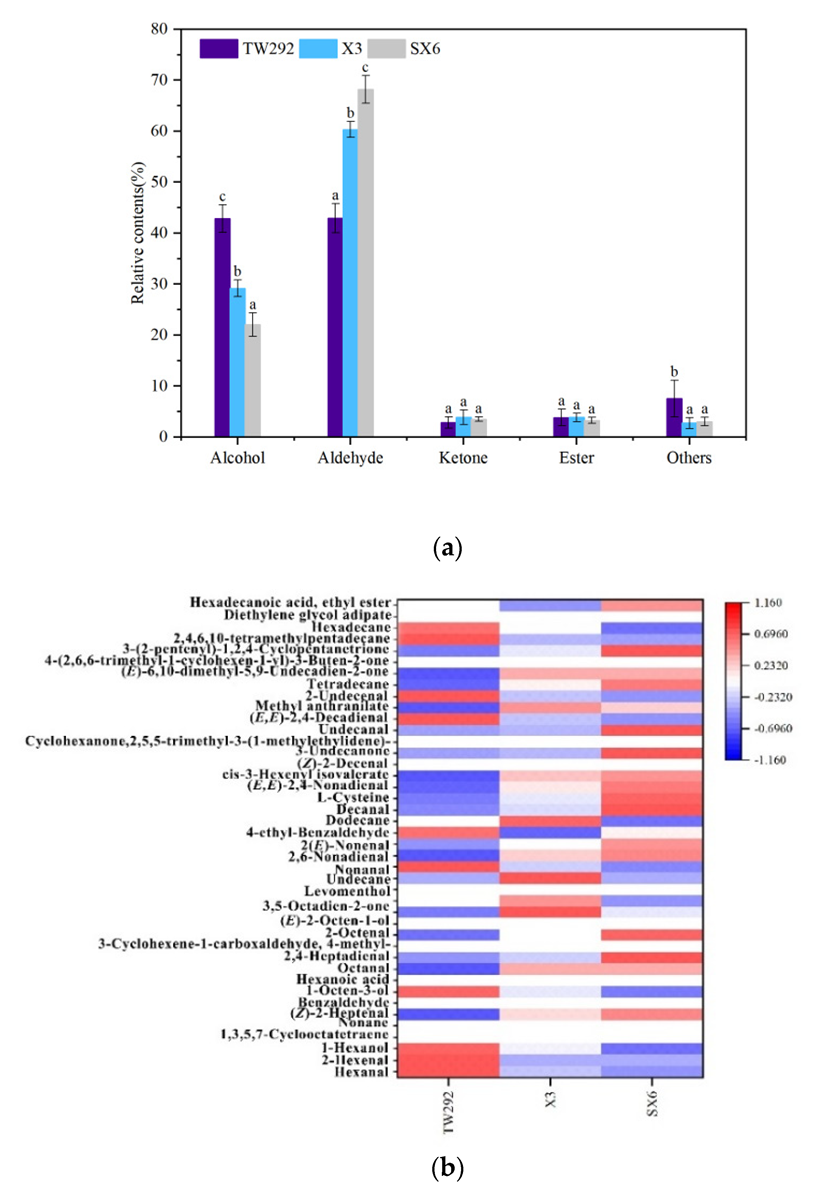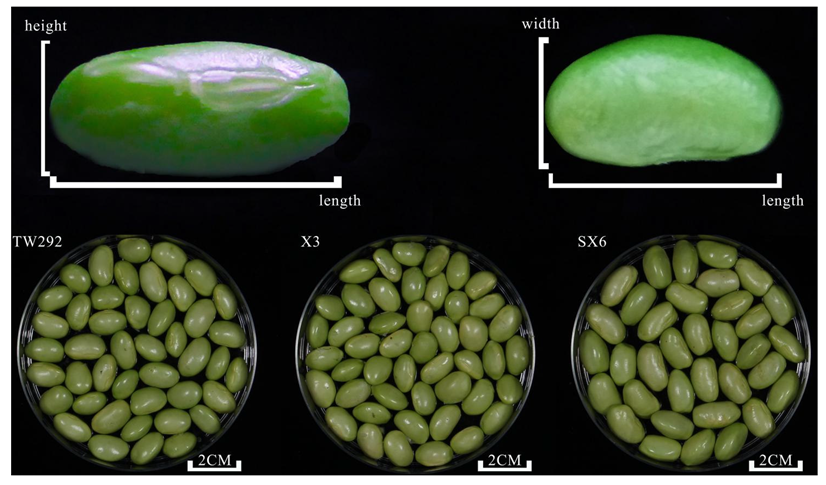Volatile Flavor Profile and Sensory Properties of Vegetable Soybean
Abstract
:1. Introduction
2. Results and Discussion
2.1. Chemical Compositions
2.2. Free Amino Acid
2.3. Sensory Properties
2.3.1. Sensory Evaluation
2.3.2. Electronic Tongue
2.4. Volatile Compounds
3. Materials and Methods
3.1. Materials
3.2. Chemicals and Reagents
3.3. Chemical Composition Analysis
3.4. Free Amino Acid Analysis
3.5. Sensory Evaluation
3.6. Electronic Tongue Analysis
3.7. Volatile Compound Analysis
3.8. Statistical Analysis
4. Conclusions
Author Contributions
Funding
Institutional Review Board Statement
Informed Consent Statement
Data Availability Statement
Acknowledgments
Conflicts of Interest
Sample Availability
References
- Czaikoski, K.; Leite, R.S.; Mandarino, J.M.G.; Carrao-Panizzi, M.C.; Silva, J.B.; Ida, E.I. Canning of vegetable-type soybean in acidified brine: Effect of the addition of sucrose and pasteurisation time on color and other characteristics. Ind. Crop. Prod. 2013, 45, 472–476. [Google Scholar] [CrossRef]
- Silva e Souza, R.; Barbosa, P.A.M.; Yassue, R.M.; Bornhofen, E.; Espolador, F.G.; Nazato, F.M.; Vello, N.A. Combining ability for the improvement of vegetable soybean. Aron. J. 2020, 112, 3535–3548. [Google Scholar] [CrossRef]
- Dong, D.K.; Fu, X.J.; Yuan, F.J.; Chen, P.Y.; Zhu, S.L.; Li, B.Q.; Yang, Q.H.; Yu, X.M.; Zhu, D.H. Genetic diversity and population structure of vegetable soybean (Glycine max (L.) Merr.) in China as revealed by SSR markers. Genet. Resour. Crop Evol. 2014, 61, 173–183. [Google Scholar] [CrossRef]
- Wszelaki, A.L.; Delwiche, J.F.; Walker, S.D.; Liggett, R.E.; Miller, S.A.; Kleinhenz, M.D. Consumer liking and descriptive analysis of six varieties of organically grown edamame-type soybean. Food Qual. Prefer. 2005, 16, 651–658. [Google Scholar] [CrossRef]
- Wu, M.L.; Chou, K.L.; Wu, C.R.; Chen, J.K.; Huang, T.C. Characterization and the possible formation mechanism of 2-acetyl-1-pyrroline in aromatic vegetable soybean (Glycine max L.). J. Food Sci. 2009, 74, 192–197. [Google Scholar] [CrossRef]
- Guo, J.; Rahman, A.; Mulvaney, M.J.; Hossain, M.M.; Basso, K.; Fethiere, R.; Babar, M.A. Evaluation of edamame genotypes suitable for growing in florida. Agron. J. 2020, 112, 693–707. [Google Scholar] [CrossRef]
- Song, J.F.; Liu, C.Q.; Li, D.J.; Gu, Z.X. Evaluation of sugar, free amino acid, and organic acid compositions of different varieties of vegetable soybean (Glycine max [L.] Merr). Ind. Crops Prod. 2013, 50, 743–749. [Google Scholar] [CrossRef]
- Xu, Y.X.; Barbaro, J.; Reese, F.; Langaigne, A.; Rutto, L.; Kering, M. Physicochemical, functional and microstructural characteristics of vegetable soybean (Glycine max) as affected by variety and cooking process. J. Food Meas. Charact. 2015, 9, 471–478. [Google Scholar] [CrossRef]
- Jiang, G.L.; Katuuramu, D.N. Comparison of seed fatty and amino acids in edamame dried by two oven-drying methods and mature soybeans. J. Sci. Food Agric. 2021, 101, 1515–1522. [Google Scholar] [CrossRef] [PubMed]
- Hou, J.F.; Wang, C.L.; Hong, X.J.; Zhao, J.M.; Xue, C.C.; Guo, N.; Gai, J.L.; Xing, H. Association analysis of vegetable soybean quality traits with SSR markers. Plant Breed. 2011, 130, 444–449. [Google Scholar] [CrossRef]
- Li, Y.S.; Du, M.; Zhang, Q.Y.; Wang, G.H.; Liu, X.B. Greater differences exist in seed protein, oil, total soluble sugar and sucrose content of vegetable soybean genotypes [Glycine max (L.) Merrill] in Northeast China. Aust. J. Crop Sci. 2012, 6, 1681–1686. [Google Scholar] [CrossRef]
- Juwattanasomran, R.; Somta, P.; Chankaew, S.; Shimizu, T.; Wongpornchai, S.; Kaga, A.; Srinives, P. A SNP in GmBADH2 gene associates with fragrance in vegetable soybean variety ’Kaori’ and SNAP marker development for the fragrance. Theor. Appl. Genet. 2010, 122, 533–541. [Google Scholar] [CrossRef] [PubMed]
- Williams, M.M. Phenomorphological Characterization of vegetable soybean germplasm lines for commercial production. Crop Sci. 2015, 55, 1274. [Google Scholar] [CrossRef]
- Zhang, Q.Y.; Li, Y.S.; Chin, K.L.; Qi, Y.D. Vegetable soybean: Seed composition and production research. Ital. J. Agron. 2017, 12, 276–282. [Google Scholar] [CrossRef] [Green Version]
- Rao, M.S.S.; Bhagsari, A.S.; Mohamed, A.I. Fresh green seed yield and seed nutritional traits of vegetable soybean genotypes. Crop Sci. 2002, 42, 1950–1958. [Google Scholar] [CrossRef]
- Abe, T.; Ujiie, T.; Sasahara, T. Varietal differences in free amino acid and sugar concentrations in immature seeds of soybean under raw and boiling treatments. J. Jpn. Soc. Food Sci. 2004, 51, 172–176. [Google Scholar] [CrossRef]
- Flores, D.; Giovanni, M.; Kirk, L.; Liles, G. Capturing and explaining sensory differences among organically grown vegetable-soybean varieties grown in Northern California. J. Food Sci. 2019, 84, 613–622. [Google Scholar] [CrossRef] [PubMed]
- Tseng, Y.H.; Lee, Y.L.; Li, R.C.; Mau, J.L. Non-volatile flavour components of ganoderma tsugae. Food Chem. 2005, 90, 409–415. [Google Scholar] [CrossRef]
- Ye, Z.; Shang, Z.X.; Li, M.Q.; Zhang, X.T.; Ren, H.B.; Hu, X.S.; Yi, J.J. Effect of ripening and variety on the physiochemical quality and flavor of fermented chinese chili pepper (Paojiao). Food Chem. 2021, 368, 130797. [Google Scholar] [CrossRef]
- Molfetta, M.; Celano, G.; Minervini, F. Functional, nutritional, and sensory quality of mixed flours-based breads as compared to durum wheat semolina-based breads. Foods 2021, 10, 1613. [Google Scholar] [CrossRef]
- Carneiro, R.; Duncan, S.E.; O’Keefe, S.F.; Yin, Y.; Zhang, B. Sensory and consumer studies in plant breeding: A guidance for edamame development in the U.S. Front. Sustain. Food Syst. 2020, 4, 124. [Google Scholar] [CrossRef]
- Suttirak, P.; Weerachai, P.; Settha, S.; Napattarapong, S.; Waya, S. Flavour compounds of the Japanese vegetable soybean ’Chakaori’ growing in Thailand. Maejo Int. J. Sci. Technol. 2007, 1, 1–9. [Google Scholar] [CrossRef] [Green Version]
- Murathan, Z.T.; Zarifikhosroshahi, M.; Kafkas, N.E. Determination of fatty acids and volatile compounds in fruits of rosehip (Rosa L.) species by HS-SPME/GC-MS and Im-SPME/GC-MS techniques. Turk. J. Agric. For. 2016, 40, 269–279. [Google Scholar] [CrossRef]
- Zhang, R.; Tang, C.; Jiang, B.; Mo, X.; Wang, Z. Optimization of HS-SPME for GC-MS analysis and its application in characterization of volatile compounds in sweet potato. Molecules 2021, 26, 5808. [Google Scholar] [CrossRef] [PubMed]
- Janes, D.; Kantar, D.; Kreft, S.; Prosen, H. Identification of buckwheat (Fagopyrum esculentum Moench) aroma compounds with GC-MS. Food Chem. 2009, 112, 120–124. [Google Scholar] [CrossRef]
- Bryant, R.J.; McClung, A.M. Volatile profiles of aromatic and nonaromatic rice cultivars using SPME/GC–MS. Food Chem. 2011, 124, 501–513. [Google Scholar] [CrossRef]
- Czerny, M.; Christlbauer, M.; Christlbauer, M.; Fischer, A.; Granvogl, M.; Hammer, M.; Hartl, C.; Hernandez, N.; Schieberle, P. Re-investigation on odour thresholds of key food aroma compounds and development of an aroma language based on odour qualities of defined aqueous odorant solutions. Eur. Food Res. Technol. 2008, 228, 265–273. [Google Scholar] [CrossRef]
- Buysse, J.; Merckx, R. An improved colorimetric method to quantify sugar content of plant-tissue. J. Exp. Bot. 1993, 44, 1627–1629. [Google Scholar] [CrossRef]
- Bradford, M. A rapid and sensitive method for the quantitation of microgram quantities of protein utilizing the principle of protein–dye binding. Anal. Biochem. 1976, 72, 248–254. [Google Scholar] [CrossRef]
- Huang, L.; Huang, Z.H.; Zhang, Y.Z.; Zhou, S.D.; Hu, W.X.; Dong, M.S. Impact of tempeh flour on the rheology of wheat flour dough and bread staling. LWT-Food Sci. Technol. 2019, 111, 694–702. [Google Scholar] [CrossRef]
- Kumar, V.; Rani, A.; Goyal, L.; Pratap, D.; Billore, S.D.; Chauhan, G.S. Evaluation of vegetable-type soybean for sucrose, taste-related amino acids, and isoflavones contents. Int. J. Food Prop. 2011, 14, 1142–1151. [Google Scholar] [CrossRef]
- Haraguchi, T.; Yoshida, M.; Kojima, H.; Uchida, T. Usefulness and limitations of taste sensors in the evaluation of palatability and taste-masking in oral dosage forms. Asian J. Pharm. Sci. 2016, 11, 479–485. [Google Scholar] [CrossRef] [Green Version]
- Duan, W.; Liang, L.; Huang, Y.; Zhang, Y.; Sun, B.; Li, L. Effect of ginger on chemical composition, physical and sensory characteristics of chicken soup. Foods 2021, 10, 1456. [Google Scholar] [CrossRef]
- Dong, W.J.; Hu, R.S.; Long, Y.Z.; Li, H.H.; Zhang, Y.J.; Zhu, K.X.; Chu, Z. Comparative evaluation of the volatile profiles and taste properties of roasted coffee beans as affected by drying method and detected by electronic nose, electronic tongue, and HS-SPME-GC-MS. Food Chem. 2019, 272, 723–731. [Google Scholar] [CrossRef] [PubMed]
- Cai, J.S.; Zhu, Y.Y.; Ma, R.H.; Thakur, K.; Zhang, J.G.; Wei, Z.J. Effects of roasting level on physicochemical, sensory, and volatile profiles of soybeans using electronic nose and hs-spme-gc-ms. Food Chem. 2021, 340, 127880. [Google Scholar] [CrossRef]
- Huang, Z.H.; Huang, L.; Xing, G.L.; Xu, X.; Tu, C.H.; Dong, M.S. Effect of co-fermentation with lactic acid bacteria and k. marxianus on physicochemical and sensory properties of goat milk. Foods 2020, 9, 299. [Google Scholar] [CrossRef] [Green Version]
- Dong, W.J.; Tan, L.H.; Zhao, J.P.; Hu, R.S.; Lu, M.Q. Characterization of fatty acid, amino acid and volatile compound compositions and bioactive components of seven coffee (coffea robusta) cultivars grown in Hainan Province, China. Molecules 2015, 20, 16687–16708. [Google Scholar] [CrossRef]






| Nutrient Content (g/100 g) | TW292 | X3 | SX6 |
|---|---|---|---|
| Crude fat | 15.40 ± 0.49 a | 22.66 ± 0.23 c | 18.71 ± 0.44 b |
| Crude protein | 35.36 ± 0.06 a | 37.44 ± 0.23 b | 39.35 ± 0.47 c |
| Soluble protein | 11.60 ± 0.10 b | 10.29 ± 0.14 a | 10.31 ± 0.12 a |
| Soluble sugar | 8.70 ± 0.13 c | 3.43 ± 0.10 a | 7.03 ± 0.27 b |
| Amino Acid | Flavor Characteristics | Content (mg/g) | ||
|---|---|---|---|---|
| TW292 | X3 | SX6 | ||
| Ala | sweetness | 1.15 ± 0.03 a | 0.6 ± 0.01 b | 1.03 ± 0.05 c |
| Gly | sweetness | 0.15 ± 0.01 c | 0.09 ± 0.01 a | 0.18 ± 0.02 b |
| Ser | sweetness | 0.09 ± 0.01 b | 0.03 ± 0.02 a | 0.52 ± 0.04 c |
| Thr | sweetness | 0.16 ± 0.03 b | 0.05 ± 0.01 a | 0.10 ± 0.02 c |
| Pro | sweetness | 0.09 ± 0.01 b | 0.07 ± 0.02 a | 0.12 ± 0.01 b |
| Asp | umami | 1.06 ± 0.04 c | 1.25 ± 0.02 a | 1.35 ± 0.04 b |
| Glu | umami | 2.79 ± 0.05 a | 2.07 ± 0.05 a | 4.73 ± 0.05 b |
| Arg | bitterness | 1.52 ± 0.02 a | 1.97 ± 0.03 a | 2.07 ± 0.13 b |
| His | bitterness | 1.52 ± 0.04 a | 0.83 ± 0.03 a | 1.66 ± 0.03 b |
| Iss | bitterness | 0.05 ± 0.01 a | 0.08 ± 0.01 b | 0.09 ± 0.01 b |
| Leu | bitterness | 0.08 ± 0.01 a | 0.13 ± 0.02 b | 0.08 ± 0.01 a |
| Met | bitterness | 0.03 ± 0.01 a | 0.03 ± 0.01 b | 0.06 ± 0.01 c |
| Phe | bitterness | 0.13 ± 0.01 c | 0.10 ± 0.02 b | 0.01 ± 0.01 a |
| Val | bitterness | 0.12 ± 0.02 b | 0.09 ± 0.02 a | 0.14 ± 0.02 c |
| Tyr | non-taste | 0.31 ± 0.02 b | 0.36 ± 0.02 a | 2.55 ± 0.04 c |
| Cys | non-taste | 0.03 ± 0.01 a | 0.02 ± 0 b | 0.05 ± 0.01 b |
| Lys | non-taste | 0.56 ± 0.01 b | 0.43 ± 0.01 a | 0.70 ± 0.02 c |
| Total FAAs | 9.84 ± 0.09 b | 8.21 ± 0.06 a | 15.43 ± 0.04 c | |
| Number | RI | Compounds | Formula | Relative Contents (%) | ||
|---|---|---|---|---|---|---|
| TW292 | X3 | SX6 | ||||
| 1 | 802 | Hexanal | C6H12O | 15.01 | 8.78 | 7.41 |
| 2 | 858 | 2-Hexenal | C6H10O | 1.54 | 1.1 | 1.04 |
| 3 | 875 | 1-Hexanol | C6H14O | 1.53 | 1.26 | 0.99 |
| 4 | 892 | 1,3,5,7-Cyclooctatetraene | C8H8 | 1.28 | ND | ND |
| 5 | 906 | Nonane | C9H20 | ND | 0.93 | ND |
| 6 | 963 | (Z)-2-Heptenal | C7H12O | 4.02 | 9.94 | 11.7 |
| 7 | 967 | Benzaldehyde | C7H6O | ND | ND | 4.58 |
| 8 | 984 | 1-Octen-3-ol | C8H16O | 41.14 | 27.8 | 18.45 |
| 9 | 1004 | Hexanoic acid | C6H12O2 | ND | ND | 0.93 |
| 10 | 1008 | Octanal | C8H16O | 1.55 | 3.89 | 3.76 |
| 11 | 1018 | 2,4-Heptadienal | C7H10O | 1.26 | 1.61 | 2.77 |
| 12 | 1040 | 3-Cyclohexene-1-carboxaldehyde, 4-methyl- | C8H12O | ND | ND | 0.78 |
| 13 | 1064 | 2-Octenal | C8H14O | 3.15 | 6.32 | 9.67 |
| 14 | 1076 | (E)-2-Octen-1-ol | C8H16O | ND | ND | 0.8 |
| 15 | 1080 | 3,5-Octadien-2-one | C8H12O | 2.37 | 3.15 | 2.57 |
| 16 | 1100 | Levomenthol | C10H20O | ND | 1.17 | 0.75 |
| 17 | 1104 | Undecane | C11H24 | 2.18 | ND | ND |
| 18 | 1109 | Nonanal | C9H18O | 6.97 | 10.29 | 6.88 |
| 19 | 1160 | 2,6-Nonadienal | C9H14O | 0.84 | 0.6 | 0.5 |
| 20 | 1167 | 2(E)--Nonenal | C9H16O | 1.42 | 2.24 | 2.43 |
| 21 | 1172 | 4-ethyl-Benzaldehyde | C9H10O | 0.36 | ND | 0.57 |
| 22 | 1202 | Dodecane | C12H26 | 1.21 | 1.03 | 1.11 |
| 23 | 1205 | Decanal | C10H20O | 1.58 | 1.92 | 1.27 |
| 24 | 1220 | L-Cysteine | C3H7NO2S | 0.38 | 0.45 | 0.6 |
| 25 | 1222 | (E,E)-2,4-Nonadienal | C9H14O | 0.2 | 0.7 | 1.52 |
| 26 | 1228 | cis-3-Hexenyl isovalerate | C11H20O2 | 1.02 | 1.95 | 2.41 |
| 27 | 1269 | (Z)-2-Decenal | C10H18O | 2.28 | 7.95 | 8.84 |
| 28 | 1295 | 3-Undecanone | C11H22O | 0.14 | ND | ND |
| 29 | 1301 | Cyclohexanone,2,5,5-trimethyl-3-(1-methylethylidene)- | C12H20O | 0.52 | 0.56 | 0.82 |
| 30 | 1314 | Undecanal | C11H22O | 0.26 | ND | ND |
| 31 | 1325 | (E,E)-2,4-Decadienal | C10H16O | 1.73 | 1.19 | 2.38 |
| 32 | 1357 | Methyl anthranilate | C8H9NO2 | 2.47 | 0.72 | 0.41 |
| 33 | 1372 | 2-Undecenal | C11H20O | 0.64 | 1.48 | 1.27 |
| 34 | 1405 | Tetradecane | C14H30 | 0.61 | 0.4 | 0.34 |
| 35 | 1462 | (E)-6,10-dimethyl-5,9-Undecadien-2-one | C13H22O | 0.2 | 0.33 | 0.4 |
| 36 | 1493 | 4-(2,6,6-trimethyl-1-cyclohexen-1-yl)-3-Buten-2-one | C13H20O | 0.13 | 0.17 | 0.16 |
| 37 | 1538 | 3-(2-pentenyl)-1,2,4-Cyclopentanetrione | C10H12O3 | 0.2 | 0.25 | 0.34 |
| 38 | 1576 | 2,4,6,10-tetramethylpentadecane | C19H40 | 0.28 | 0.18 | 0.16 |
| 39 | 1606 | Hexadecane | C19H40 | 0.32 | 0.3 | 0.25 |
| 40 | 1651 | Diethylene glycol adipate | C10H18O6 | 0.24 | ND | ND |
| 41 | 2000 | Hexadecanoic acid, ethyl ester | C18H36O2 | ND | 0.14 | 0.21 |
| Name | Place of Origin | Length/cm | Width/cm | Height/cm | Hundred-Grain Weight/g |
|---|---|---|---|---|---|
| TW292 | Taiwan | 1.5 | 1.0 | 0.8 | 64.438 |
| X3 | Shanghai | 1.5 | 1.1 | 0.8 | 73.327 |
| SX6 | Jiangsu | 1.5 | 1.2 | 1.0 | 106.619 |
Publisher’s Note: MDPI stays neutral with regard to jurisdictional claims in published maps and institutional affiliations. |
© 2022 by the authors. Licensee MDPI, Basel, Switzerland. This article is an open access article distributed under the terms and conditions of the Creative Commons Attribution (CC BY) license (https://creativecommons.org/licenses/by/4.0/).
Share and Cite
Guo, L.; Huang, L.; Cheng, X.; Gao, Y.; Zhang, X.; Yuan, X.; Xue, C.; Chen, X. Volatile Flavor Profile and Sensory Properties of Vegetable Soybean. Molecules 2022, 27, 939. https://doi.org/10.3390/molecules27030939
Guo L, Huang L, Cheng X, Gao Y, Zhang X, Yuan X, Xue C, Chen X. Volatile Flavor Profile and Sensory Properties of Vegetable Soybean. Molecules. 2022; 27(3):939. https://doi.org/10.3390/molecules27030939
Chicago/Turabian StyleGuo, Luping, Lu Huang, Xi Cheng, Yuan Gao, Xiaoyan Zhang, Xingxing Yuan, Chenchen Xue, and Xin Chen. 2022. "Volatile Flavor Profile and Sensory Properties of Vegetable Soybean" Molecules 27, no. 3: 939. https://doi.org/10.3390/molecules27030939
APA StyleGuo, L., Huang, L., Cheng, X., Gao, Y., Zhang, X., Yuan, X., Xue, C., & Chen, X. (2022). Volatile Flavor Profile and Sensory Properties of Vegetable Soybean. Molecules, 27(3), 939. https://doi.org/10.3390/molecules27030939







